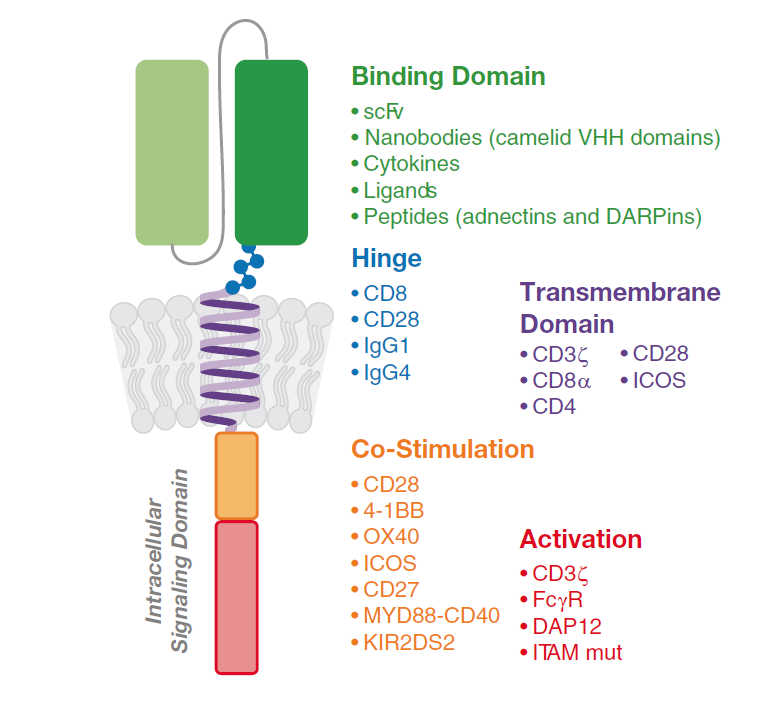Chimeric antigen receptors (CARs) are designed and engineered in a modular fashion that typically consists of an extracellular target-binding domain, a hinge region, a transmembrane domain that anchors the CAR to the cell membrane, and one or more intracellular domains that transmit activation signals. Depending on the number of costimulatory domains, Designed and engineered CARs can be classified into first (CD3ζ only), second (one costimulatory domain + CD3ζ), or third generation CARs (more than one costimulatory domain + CD3ζ).
Common co-stimulatory molecules utilized in chimeric antigen receptors (CARs).
| CSM | Ligand(s) | Biological characteristics |
|---|---|---|
| CD28 | CD80/ CD86 | Expressed in resting and activated T cells. Promotes quick activation, cytokine production and slight proliferation through the PI3-kinase-AKT pathway. Promotes effector memory phenotype with high glycolytic metabolism and diminished persistence in CAR-T cells. Can promote antigen– independent exhaustion. Might favor CD4 + T cell expansion. |
| 4-1BB (CD137) | 4-1BBL (CD137L) | Involved in T cell activation and persistence by recruiting TRAF. In CAR-T cells is associated with a delayed stimulation but greater proliferative capacity compared to CD28. It is associated with a central memory phenotype and increased oxidative metabolism and persistence. Inhibits antigen - independent exhaustion in CAR-T cells. |
| ICOS (CD278) | ICOSL (CD275) | Cooperates with 4-1BB signaling in CAR-T cell function and persistence. ICOS positioning proximal to the cell membrane can remarkably augment the effector function and persistence of CAR-T cells. It is associated with Th1 and Th17 phenotypes. |
| OX40 (CD134) | OX40L (CD252) | Highly expressed in activated T cells. Stimulates T cell proliferation and cytokine production. Contributes to regulatory T cells (Treg) suppression. |
| CD27 | CD70 | Plays a role in survival of activated CAR-T cells by upregulating Bcl-X(L) proteins. Loss of the co-stimulatory molecules CD27 and CD28 is a common phenomenon during T cell senescence. |
| CD40 | CD40L (CD154) | CD40 signaling increases proliferation and secretion of cytokines in CAR-T cells. Expression of CD40 in T cells is restricted to activated T cells. |
| KIR2DS2 | Ligand uncharacterized | Killer cell immunoglobulin-like receptor (KIR) KIR2DS2 induces natural killer (NK) cell activation upon ligation and is associated with protection against certain cancers and viral infections. |
Fusion Biosciences could construct any customized CAR via combination of your picked components.
| Binding domains | Hinge | Transmembrane domains | Co-Stimulation | Activation domain | |
| Component Candidate* | scFv, VHH, VH, Cytokines, Ligands, Peptides | CD8, CD28, IgG1, IgG4 | CD3ζ, CD4, CD8α, CD28, ICOS | 4-1BB, CD27, CD28, ICOS, KIR2DS2, MYD88-CD40, OX40 | CD3ζ, DAP12, FcγR, ITAM mutation |
| 2nd generation CAR | pick 1 or 1+ | Pick 1 | pick 1 | pick 1 | pick 1 |
| 3rd generation CAR | pick 1 or 1+ | pick 1 | pick 1 | pick 2 and 2+ | pick 1 |
Ordering Information
Customized Chimeric Antigen Receptor (CAR) Design and Construction Services
| Catalog | Description | Unit | Price |
|---|---|---|---|
| 62101 | Second generation CAR design and construction | 1 Project | Contact Us |
| 62102 | Third generation CAR design and construction | 1 Project | Contact Us |
| 62103 | Next Generation CAR design and construction | 1 Project | Contact Us |
For complex projects, please fill the form for a customized quotation and proposal!

